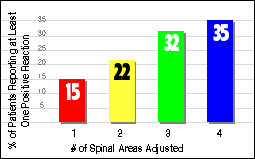New York's highest court of appeals has held that no-fault insurers cannot deny no-fault benefits where they unilaterally determine that a provider has committed misconduct based upon alleged fraudulent conduct. The Court held that this authority belongs solely to state regulators, specifically New York's Board of Regents, which oversees professional licensing and discipline. This follows a similar recent ruling in Florida reported in this publication.
Unexpected Positive Nonmusculoskeletal Side Effects
A retrospective study conducted in Sweden1 has determined that about one in four chiropractic patients experiences some form of "positive nonmusculoskeletal side effect" after spinal manipulative therapy (SMT). In addition, the percentage of patients who experience positive side effects increases with the number of spinal regions adjusted.
The Swedish researchers asked all members of the Swedish Chiropractors Association (SCA) to participate in the study. Eighty-one percent of the SCA membership complied. Each doctor of chiropractic gathered data from 20 patients over a three-week period for a total of 1,504 valid patient questionnaires. Patients were included if they had been previously adjusted within the last two weeks for musculoskeletal complaints. The patients were asked if after their previous visit they "experienced any positive changes that do not seem to have anything to do with your back problem?
At least one positive side effect or reaction was reported by 23 percent of the respondents. The more spinal areas that were adjusted, the better their chances of experiencing at least one positive reaction:

The positive, nonmusculoskeletal reactions appear to cluster into a number of system/organ-related classifications. Of those patients who experienced them, here is the breakdown by percentage:
Respiratory System: 26%
Digestive System: 25%
Circulatory System/Heart: 14%
Eyes/Vision: 14%
The benefits experienced can also be broken down into subcategories:
Easier to Breathe: 21%
Improved Digestive Function: 20%
Clearer/Better/Sharper Vision: 11%
Better Circulation: 7%
Changes in Heart Rhythm/Blood Pressure: 5%
Less Ringing in the Ears/Improved Hearing: 4%
The authors, as is typical in research papers, are careful to point out the limitations of extrapolating the findings. They note that the study does not demonstrate whether the statistical link between treatment and reaction is causal. They assert that "the absence of an untreated control group makes it impossible to say whether these reactions are treatment-specific, or if they simply represent normal fluctuations of common symptoms of physiologic function. While these results are very exciting, it is clear that additional research is needed.
Reference
1. Leboeuf-Yde C, Axen I, Ahlefeldt G, Lidefelt P, Rosenbaum A, Thurnherr T. The types of improved nonmusculoskeletal symptoms reported after chiropractic spinal manipulative therapy. J Manipulative Physiol Ther 1999;22:559-64.



